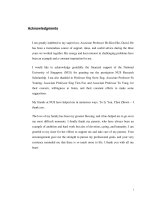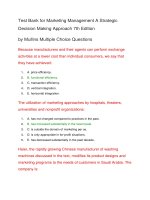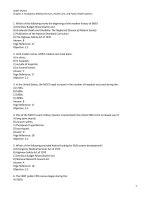Business statistics a decision making approach 6th edition ch17ppln
Bạn đang xem bản rút gọn của tài liệu. Xem và tải ngay bản đầy đủ của tài liệu tại đây (541.84 KB, 55 trang )
Business Statistics:
A Decision-Making Approach
6th Edition
Chapter 17
Introduction to Quality and
Statistical Process Control
Business Statistics: A Decision-Making Approach, 6e © 2010 PrenticeHall, Inc.
Chap 17-1
Chapter Goals
After completing this chapter, you should be
able to:
Use the seven basic tools of quality
Construct and interpret x-bar and R-charts
Construct and interpret p-charts
Construct and interpret c-charts
Business Statistics: A Decision-Making Approach, 6e © 2010 PrenticeHall, Inc.
Chap 17-2
Chapter Overview
Quality Management and
Tools for Improvement
Philosophy of
Quality
Deming’s 14
Points
Juran’s 10
Steps to
Quality
Improvement
Business Statistics: A Decision-Making Approach, 6e © 2010 PrenticeHall, Inc.
Tools for Quality
Improvement
The Basic
7 Tools
Control
Charts
X-bar/R-charts
p-charts
c-charts
Chap 17-3
Themes of Quality
Management
Primary focus is on process improvement
Most variations in process are due to systems
Teamwork is integral to quality management
Customer satisfaction is a primary goal
Organization transformation is necessary
It is important to remove fear
Higher quality costs less
Business Statistics: A Decision-Making Approach, 6e © 2010 PrenticeHall, Inc.
Chap 17-4
Deming’s 14 Points
1. Create a constancy of purpose toward
improvement
2. Adopt the new philosophy
Better to improve now than to react to problems later
3. Stop depending on inspection to achieve
quality -- build in quality from the start
become more competitive, stay in business, and provide jobs
Inspection to find defects at the end of production is too late
4. Stop awarding contracts on the basis of
low bids
Better to build long-run purchaser/supplier relationships
Business Statistics: A Decision-Making Approach, 6e © 2010 PrenticeHall, Inc.
Chap 17-5
Deming’s 14 Points
(continued)
5. Improve the system continuously to improve
quality and thus constantly reduce costs
6. Institute training on the job
7. Institute leadership
Workers and managers must know the difference between common
cause and special cause variation
Know the difference between leadership and supervision
8. Drive out fear so that everyone may work
effectively.
9. Break down barriers between departments so
that people can work as a team.
Business Statistics: A Decision-Making Approach, 6e © 2010 PrenticeHall, Inc.
Chap 17-6
Deming’s 14 Points
(continued)
10. Eliminate slogans and targets for the
workforce
They can create adversarial relationships
11. Eliminate quotas and management by
objectives
12. Remove barriers to pride of workmanship
13. Institute a vigorous program of education
and self-improvement
14. Make the transformation everyone’s job
Business Statistics: A Decision-Making Approach, 6e © 2010 PrenticeHall, Inc.
Chap 17-7
Juran’s 10 Steps to Quality
Improvement
1. Build awareness of both the need for
improvement and the opportunity for
improvement
2. Set goals for improvement
3. Organize to meet the goals that have been
set
4. Provide training
5. Implement projects aimed at solving
problems
Business Statistics: A Decision-Making Approach, 6e © 2010 PrenticeHall, Inc.
Chap 17-8
Juran’s 10 Steps to Quality
Improvement
(continued)
6. Report progress
7. Give recognition
8. Communicate the results
9. Keep score
10. Maintain momentum by building
improvement into the company’s regular
systems
Business Statistics: A Decision-Making Approach, 6e © 2010 PrenticeHall, Inc.
Chap 17-9
The Deming Cycle
Plan
Act
The
Deming
Cycle
Study
Business Statistics: A Decision-Making Approach, 6e © 2010 PrenticeHall, Inc.
Do
The key is a
continuous
cycle of
improvement
Chap 17-10
The Basic 7 Tools
1.
Process Flowcharts
2.
Brainstorming
3.
Fishbone Diagram
4.
Histogram
5.
Trend Charts
6.
Scatter Plots
7.
Statistical Process
Control Charts
Business Statistics: A Decision-Making Approach, 6e © 2010 PrenticeHall, Inc.
Chap 17-11
The Basic 7 Tools
(continued)
1.
2.
3.
4.
5.
6.
7.
Process Flowcharts
Brainstorming
Fishbone Diagram
Histogram
Trend Charts
Scatter Plots
Statistical Process
Control Charts
Map out the process to better
visualize and understand
opportunities for improvement
Business Statistics: A Decision-Making Approach, 6e © 2010 PrenticeHall, Inc.
Chap 17-12
The Basic 7 Tools
(continued)
1.
2.
3.
4.
5.
6.
7.
Process Flowcharts
Brainstorming
Fishbone Diagram
Histogram
Trend Charts
Scatter Plots
Statistical Process
Control Charts
Show patterns of variation
Fishbone (cause-and-effect) diagram:
Cause 1
Cause 2
Sub-causes
Problem
Sub-causes
Cause 3
Business Statistics: A Decision-Making Approach, 6e © 2010 PrenticeHall, Inc.
Cause 4
Chap 17-13
The Basic 7 Tools
(continued)
1.
2.
3.
4.
5.
6.
7.
Identify trend
Process Flowcharts
Brainstorming
Fishbone Diagram
Histogram
Trend Charts
Scatter Plots
Statistical Process
Control Charts
y
y
time
Examine relationships
Business Statistics: A Decision-Making Approach, 6e © 2010 PrenticeHall, Inc.
x
Chap 17-14
The Basic 7 Tools
(continued)
1.
2.
3.
4.
5.
6.
7.
Process Flowcharts
Brainstorming
Fishbone Diagram
Histogram
Trend Charts
Scatter Plots
Statistical Process
Control Charts
Examine the performance
of a process over time
X
time
Business Statistics: A Decision-Making Approach, 6e © 2010 PrenticeHall, Inc.
Chap 17-15
Introduction to Control
Charts
Control Charts are used to monitor variation in
a measured value from a process
Exhibits trend
Can make correction before process is out of control
A process is a repeatable series of steps
leading to a specific goal
Inherent variation refers to process variation
that exists naturally. This variation can be
reduced but not eliminated
Business Statistics: A Decision-Making Approach, 6e © 2010 PrenticeHall, Inc.
Chap 17-16
Process Variation
Total Process
Common Cause
Special Cause
=
+
Variation
Variation
Variation
Variation is natural; inherent in the world
around us
No two products or service experiences
are exactly the same
With a fine enough gauge, all things can
be seen to differ
Business Statistics: A Decision-Making Approach, 6e © 2010 PrenticeHall, Inc.
Chap 17-17
Sources of Variation
Total Process
Common Cause
Special Cause
=
+
Variation
Variation
Variation
Variation is often due to differences in:
People
Machines
Materials
Methods
Measurement
Environment
Business Statistics: A Decision-Making Approach, 6e © 2010 PrenticeHall, Inc.
Chap 17-18
Common Cause Variation
Total Process
Common Cause
Special Cause
=
+
Variation
Variation
Variation
Common cause variation
naturally occurring and expected
the result of normal variation in
materials, tools, machines, operators,
and the environment
Business Statistics: A Decision-Making Approach, 6e © 2010 PrenticeHall, Inc.
Chap 17-19
Special Cause Variation
Total Process
Common Cause
Special Cause
=
+
Variation
Variation
Variation
Special cause variation
abnormal or unexpected variation
has an assignable cause
variation beyond what is considered
inherent to the process
Business Statistics: A Decision-Making Approach, 6e © 2010 PrenticeHall, Inc.
Chap 17-20
Statistical Process Control
Charts
Show when changes in data are due to:
Special or assignable causes
Fluctuations not inherent to a process
Represents problems to be corrected
Data outside control limits or trend
Common causes or chance
Inherent random variations
Consist of numerous small causes of random
variability
Business Statistics: A Decision-Making Approach, 6e © 2010 PrenticeHall, Inc.
Chap 17-21
Control Chart Basics
Special Cause Variation:
Range of unexpected variability
UCL
Common Cause
Variation: range of
expected variability
+3σ
Process Average
- 3σ
LCL
time
UCL = Process Average + 3 Standard Deviations
LCL = Process Average – 3 Standard Deviations
Business Statistics: A Decision-Making Approach, 6e © 2010 PrenticeHall, Inc.
Chap 17-22
Process Variability
Special Cause of Variation:
A measurement this far from the process average
is very unlikely if only expected variation is present
UCL
±3σ → 99.7% of
process values
should be in this
range
Process Average
LCL
time
UCL = Process Average + 3 Standard Deviations
LCL = Process Average – 3 Standard Deviations
Business Statistics: A Decision-Making Approach, 6e © 2010 PrenticeHall, Inc.
Chap 17-23
Statistical Process Control
Charts
Statistical Process
Control Charts
X-bar charts
and R-charts
Used for
measured
numeric data
p-charts
Used for
proportions
(attribute data)
Business Statistics: A Decision-Making Approach, 6e © 2010 PrenticeHall, Inc.
c-charts
Used for
number of
attributes per
sampling unit
Chap 17-24
x-bar chart and R-chart
Used for measured numeric data from a
process
Start with at least 20 subgroups of observed
values
Subgroups usually contain 3 to 6 observations
each
Business Statistics: A Decision-Making Approach, 6e © 2010 PrenticeHall, Inc.
Chap 17-25









